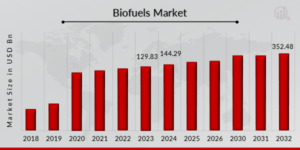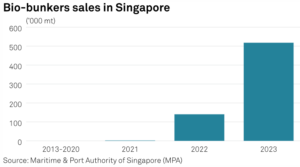The evolution of the bioenergy market in Asia
See what the main initiatives are in the bioenergy market in Asia, mainly in relation to the aviation and maritime transportation sector.
The growing demand for biofuels is driving the bioenergy market, especially in Asia. Several countries on the continent have invested in this renewable source and set increasingly ambitious production targets for the future.
Even at an early stage, the local bioenergy sector shows high potential due to the interest of large companies and governments. Currently, Singapore, China and India are leaders in investments to reduce dependence on oil exports. Ethanol, produced from sugar cane, which is abundant in the region, has become the main biofuel in Asia.
The growing demand for biofuels in Asia
According to Market Research Future, the global bioenergy market is expected to grow by 11.74% a year over the next decade, rising from US$ 129.83 billion in 2023 to US$ 352.48 billion in 2032. The institution also indicates that, as demand for biofuels increases, technology will follow, developing more efficient and economical products.
See below for a graphic projection:

Southeast Asia plays a significant role in sustainable fuel production, mainly in the transportation sector. The main growing biofuels are aviation biokerosene (SAF) and marine biofuel (biobunker). Learn more about these two fronts of the bioenergy sector:
● SAF
S&P Global reports that demand for SAF (Sustainable Aviation Fuel) is expected to increase significantly, peaking in 2035. Market efforts and regulations will be crucial to dominating the fuel mix by 2050.
Recently, Singapore’s National Research Foundation launched a $90 million program focused on the production of SAF and other renewable sources. These investments aim to support the global targets for the use of this fuel in aviation, which are expected to be 3.24% by 2040 and 24.06% by 2050.
The numbers are growing with the world’s largest SAF production plant: Neste Singapore. The company invested US$1.4 billion in a biorefinery in 2019 and has already signed contracts with Singapore Airlines and Scoot.
Read also:
- The Evolution of the Bioenergy Market in the World
In addition, Thailand’s Bangchak Group is developing a new SAF plant with the capacity to produce 1 million liters of biofuel daily, scheduled to start up in the second quarter of 2025.
The MSCI Sustainability Institute has also published data on the use of SAF. According to the institution, scale will be essential for the continued deployment of this biofuel. The greater the participation of companies, the greater the results of the initiatives. See the list of airlines with SAF targets by 2030:

● Biobunker
According to S&P Global, biobunker sales in Singapore will increase from 140,200 tons in 2022 to 518,000 tons in 2023. The Maritime and Port Authority of Singapore has highlighted this growth in the graph below:

This advance in the bioenergy sector in Asia has the support of major container shipping companies such as Maersk and Hapag-Lloyd, which are supplied with bunker fuel in Singapore and have structured targets to achieve net zero emissions by 2050.
Initiatives also support this progress in the use of maritime biofuels. The European Union has adopted the FuelEU Maritime program, which sets maximum limits for greenhouse gases (GHG) generated by ships docking in European ports. The aim is to gradually reduce GHGs in maritime transport, with targets of 2% by 2025 and up to 80% by 2050.
Read also:
- Driving season: the impact on the North American fuel market
The challenges of the bioenergy market in Asia
The bioenergy market in Asia is in its infancy and faces common barriers for a raw material on the rise. The MSCI Sustainability Institute cites market immaturity and price as the main obstacles for the future.
To increase the biofuel blending rate by 2030, numerous partnerships between carriers and producers are needed to expand the supply of SAF and biobunkers. In 2022, for example, SAF production represented just 0.1% of the total volume of conventional aviation fuel.
IATA (International Air Transport Association) data shows an increase in SAF prices and low initial growth in supply:

The institution itself states that a combination of technological solutions will be needed, with SAF being a key component in reducing carbon emissions in the air transport sector. For a substantial increase in the production of this biofuel, IATA points to greater collaboration between governments and the industry, as well as synchronized strategic policies and time for aviation to meet realistic targets.
Some short-term measures are being adopted to advance the bioenergy market in Asia. Singapore’s Minister of Transport has announced that there will be a tax on renewable fuel and the cost will be passed on to the end customer until the industry finds a more viable financing model.
By 2050, the costs of achieving net zero emissions are estimated at between US$1.45 trillion and US$3.2 trillion, depending on the aviation sector. To achieve this, it is necessary to increase the use of SAF to 65% in this period.
Read also:
- Biodiesel blend increases to 14% in Brazil: what does this mean?
Main initiatives of other Asian countries in the bioenergy market
In addition to Singapore, other Asian nations are also encouraging the use of biofuels with structured targets for the future. Here are the main ones:
- Malaysia has set a target of a 47% SAF blend by 2050;
- India aims to have 1% SAF in the fuel mix by 2027 and 2% by 2028. The country can also boost its biofuel production through the Global Biofuels Alliance, launched in 2023 with eight other countries;
- China announced in November 2023 that it intends to launch projects to encourage the production and consumption of biofuels, as well as investing in advanced technologies for production from agricultural waste and algae;
- In Japan, SAF is expected to replace 10% of aviation fuel by 2030.
Source: The Straits Times
Hedgepoint Newsletter
Receive other informative content about the commodities market directly in your e-mail. Subscribe to Hedgepoint’s newsletter and turn risks into opportunities with rich materials prepared by experienced professionals.






